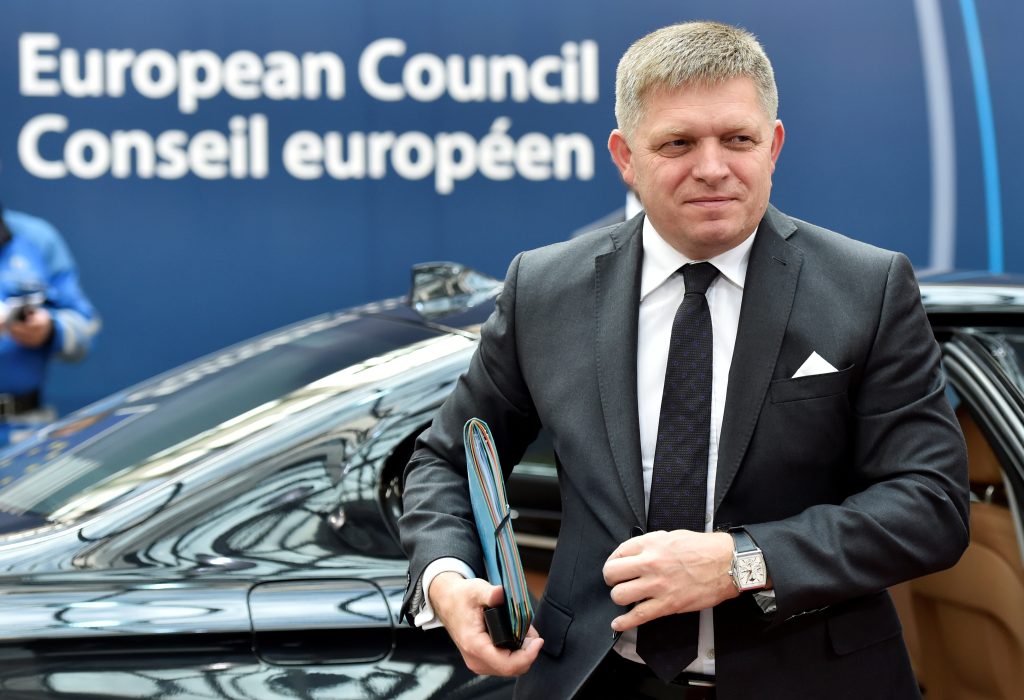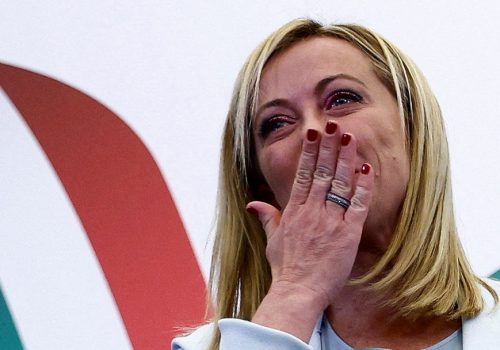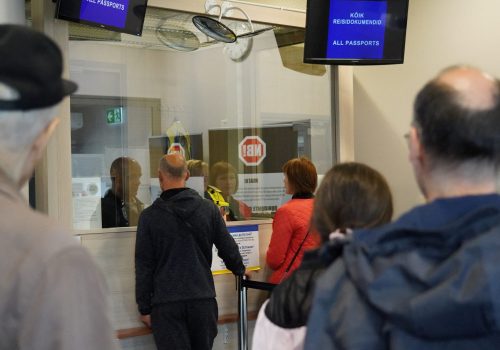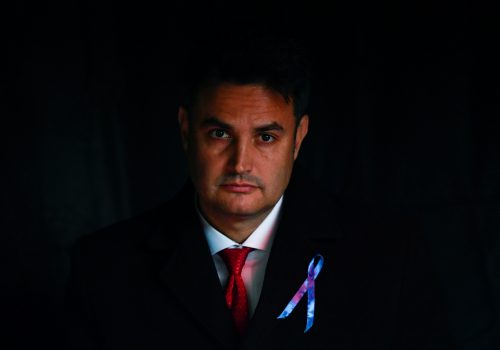Slovakia’s center-right minority government fell on December 15 after narrowly losing a no-confidence vote. The country has reached a crossroads and is edging closer to a scenario that could allow former Prime Minister Robert Fico to return to power. This is not an appealing prospect for Slovakia, its neighbors, Europe, or transatlantic allies.
A nationalistic populist, Fico has repeatedly stressed that he would stop military aid for Ukraine if he enters office, echoing the opinion of an important part of his electoral base. If Fico returns to power, he will steer Slovakia closer to Viktor Orbán’s Hungary, with adverse implications for European Union (EU) and NATO cohesion.
Slovak politics can go either way from here. There’s still a chance that the liberal, pro-Western camp will handle the crisis to its advantage. But it is important to pay attention to what’s going on in Bratislava and eventually to motivate Fico’s opponents to get together to prevent a Slovak shift toward Hungary and Russia. Too much is at stake here for Europeans and the transatlantic community to remain passive.
What happened: blame Matovič
The no-confidence vote was called by the liberal conservatives of the Freedom and Solidarity party (SaS) of Richard Sulík. SaS was part of the governing coalition until September when the party left over long-term disputes with Minister of Finance Igor Matovič.
Matovič is a leader of the governing OLANO party and served as prime minister until he was forced to swap positions with party colleague Eduard Heger in March 2021 after coalition partners learned about a secret deal Matovič had struck with Russia to purchase Sputnik COVID-19 vaccines. However, the unpredictable Matovič has continued—as Slovaks call it—to throw political nukes.
When SaS members’ patience ran out, they signaled they would call a no-confidence vote if Matovič did not resign. He first agreed and went to the presidential palace to hand over his resignation letter. Then something awkward happened: He changed his mind when in the presidential palace and pulled his resignation. This was the final straw for SaS. Yet the fall of Heger’s government is no surprise. The ruling coalition was plagued by discord and had been paralyzed for some time.
What will happen: four options
Heger’s cabinet resigned before President Zuzana Čaputová on December 16. What will happen next is an open question. Here are four possibilities:
- Čaputová could form a caretaker government that can stay in place until regular elections that are scheduled for the spring of 2024. However, there’s no tradition in Bratislava for this solution. The opposition has already objected, and Čaputová herself has said this is not her preferred choice. Nevertheless, she can still use it as a last resort option or as a threat to get the National Council (Slovak parliament) to explore other options.
- Heger’s cabinet-in-demission could govern for a longer period with limited powers. But Slovakia needs strong leadership amid multiple crises (security, energy, health, inflation), and nobody seems to favor this alternative. It would also undermine parliament by effectively overruling the outcome of the vote of no confidence.
- Čaputová could call for early elections. Yet not every parliamentarian is eager to see early elections. Some lawmakers are afraid of losing their jobs while political parties could lose vital access to financial resources. (Groups that make it into the National Council are reimbursed on an annual basis.) A bill to call for fresh elections would need the support of 60 percent of lawmakers, which simply isn’t there now.
- At the same time, many lawmakers are exploring the option of a reformed center-right coalition without Matovič, as a “sine qua non” condition. Even Sulík—whose SaS party left the coalition—appears now to be on board. They would need a majority in parliament, not an easy task after the no-confidence vote. However, the first important signal that they can succeed in reforming the coalition is the December 22 agreement on Slovakia’s budget for next year. Heger’s government-in-demission reached a deal in cooperation with SaS. The gravity of the situation, where a provisory budget would limit the government’s ability to help people cope with skyrocketing energy prices, motivated them to compromise. Matovič’s removal on December 23 was part of the deal.
If elections were to be held today, the Voice–Social Democracy party led by Peter Pellegrini would likely win. The party split off from SMER–Social Democracy, run by Fico, who is currently polling in second place.
Pellegrini—whose party is sometimes dubbed Fico’s B team by critics—is not eager to work with his former boss. However, if it will be the only way for him to get back into power, Pellegrini could agree. Together with Fico, they’ll need another partner. They could turn to ultranationalist, neo-Nazi groups such as People’s Party Our Slovakia or the breakaway Republika party.
Realistically, a center-right coalition opposed to Fico could come to power if it gets enough votes in an election so that Pellegrini can form the government with them rather than joining Fico.
What to watch: Dark matter
Former US Secretary of State Madeleine Albright once called Slovakia “the black hole of Europe” when in the mid-1990s then Prime Minister Vladimir Mečiar—a forerunner of nationalistic populism in the region—did his best to disrupt the country’s move to join NATO and the EU.
Since then, Slovakia has often been praised as the region’s champion of liberal democracy. The 2019 election of Čaputová—a former environmental activist and liberal democrat—as president solidified that reputation. The coalition government that just fell could have added to that growing stature after Fico’s reign, which was marked by the erosion of rule of law and democracy.
Fico was forced to step down after the 2018 murder of investigative journalist Ján Kuciak, whose work exposed how deeply Slovak police, the justice system, and some politicians were colluding with criminals, including the Italian mafia. The investigation into those allegations is still ongoing, and critics argue that one of Fico’s motivations for his government’s comeback is to terminate it.
At the moment, when the country is preparing for the thirtieth anniversary of its independence on January 1, the mood among Slovak voters is one of deep frustration and apathy, which creates political space for populists and extremists.
Aside from euroskepticism, a government including Fico could add another challenge to NATO and EU efforts to maintain unity in support of Ukraine. In fact, since Fico was forced into the opposition, he has taken even more pro-Russian positions than Orbán.
In July, Ukraine’s Center for Countering Disinformation (part of the National Security and Defense Council) listed Fico among the politicians spreading Russian propaganda. From his standpoint, what we see in Ukraine is a war between Russia and the United States, where both are to blame. He has repeatedly stated that he wouldn’t send a single bullet to Ukraine.
Unlike Italy’s new Prime Minister Giorgia Meloni, who transformed her country’s far-right politics by turning against Russian aggression, Slovak politicians are actually fighting for a slice of the country’s pro-Russian electorate. After former Russian intelligence agent Sergei Skripal and his daughter were poisoned in the British city of Salisbury in 2018, the unwillingness to alienate pro-Russian voters meant that Bratislava was the only EU capital other than Vienna that didn’t expel a single Russian diplomat.
Today, Slovakia hosts a multinational NATO battlegroup put together to strengthen the Alliance’s eastern flank. A significant portion of Fico’s voter base is against the foreign military presence in the country. If he returns to power, Czech, German, Dutch, Polish, and US military contingents currently present in Slovakia could come under scrutiny.
Segments of the Slovak population continue to perceive their country as a victim that suffered under the Austro-Hungarian Empire and later within Czechoslovakia. During the 1990s under Mečiar’s rule, anti-American sentiments started to rise. These further intensified after the NATO bombing of Serbia and later with the US wars in Iraq and Afghanistan. Pan-Slavism and targeted disinformation campaigns have played a role in strengthening pro-Russian narratives as well.
What should be done: engage Slovaks
Currently, there’s no other country within the EU closer to forming such a hard-line nationalist government than Slovakia, especially if two minor neo-Nazi parties (People’s Party Our Slovakia and Republika) are in. It is important to mobilize efforts to stop such a scenario from unfolding.
Slovakia’s partners, including the United States, should do their best to convince those opposed to Fico to join forces. That is not an easy task given the deep divisions within Slovak politics, but there’s still time to do it.
Friends and allies of Slovakia should also talk to Pellegrini, offering him a mix of carrots and sticks to discourage him from cooperating with Fico and the far-right groups.
Last but not least, it is important for US and EU politicians and diplomats to maintain contact with Fico. As populist, pro-Russian, and mercurial as he has become, he also used to be a great political gambler, an opportunist, a pragmatist similar to Orbán or Turkey’s Recep Tayyip Erdogan who is capable of U-turns if they worked for him. Fico might have lost that aspect of his political personality, but if it can be revived with efforts to show that working with the West is a better bet than siding with Russia, it is worth a try.
Petr Tůma is a visiting fellow at the Europe Center and a Czech career diplomat with expertise on Europe, the Middle East, and transatlantic relations.
Further reading
Mon, Sep 26, 2022
Which Giorgia Meloni will Washington get?
New Atlanticist By Alissa Pavia
The Biden administration should adopt a more cautious approach toward the next Italian prime minister than it has so far.
Fri, Sep 23, 2022
The EU’s Russia visa ban debate reveals the bloc’s new power center
New Atlanticist By Petr Tůma
The consensus on visa policy toward Russia is yet another sign of Central and Eastern Europe’s rise to political prominence.
Thu, Nov 18, 2021
‘Hungary is not a democracy anymore,’ says opposition leader
New Atlanticist By Dan Peleschuk
Péter Márki-Zay, an engineer-turned-politician who now leads Hungary's opposition, joined the Atlantic Council for a discussion about the future of his country.
Image: Slovakia's then Prime Minister Robert Fico arrives at the EU summit meeting in Brussels, Belgium, October 19, 2017. REUTERS/Eric Vidal



